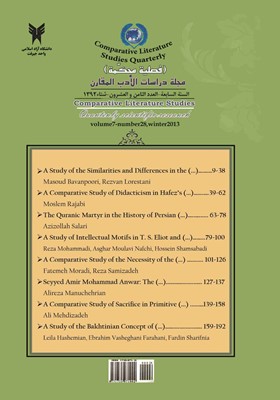A Study of Intellectual Motifs in T. S. Eliot and Adonis’s New Critical Approaches
Subject Areas : شعرReza Mohammadi 1 , Asghar Moulavi Nafchi 2 , Hossein Shamsabadi 3
1 - PhD student of Arabic language and literature, Hakim Sabzevari University, Iran
2 - Lecturer of English language and literature, Hakim Sabzevari University, Iran
3 - Associate Professor of Arabic language and literature, Hakim Sabzevari University, Iran.
Keywords: symbolism, نمادپردازی, Adonis, نقد نو, نقد عینی, بههمپیوستگی عینی, شخصیتزدایی, الیوت, ادونیس, de-characterization, New Criticism, objective correlative, objective criticism, T. S. Eliot,
Abstract :
T. S. Eliot’s peculiar symbolism is professionally distinctive. Eliot bases the atypical language of poetry on paradox, irony, ambiguity, myth, and symbol; and achieves objective and tangible imagery in an exclusively unexpected method, consequently intertwining sensibility and emotion. This multifarious method relies on Eliot’s theory of the objective correlative, which he applied to the Waste Land. The objective correlative firstly relies on the de-characterization of the author, this being the cornerstone of new critical methodology, and sees poetry as an independent and self-sufficient phenomenon that should be in turn analyzed through such internal and essential criteria as complexity, ambiguity, and textual cohesion and coherence in order to study textual unity and integrity. Secondly this theory is closely associated with symbolism both as a literary technique and school. Thirdly, there is the incorporation of tradition in poetry which reflects the neoclassical orientation of this theory. Adonis is among those poet-critics who have indirectly been impressed by Eliot’s theory of the objective correlative. Adonis, like Eliot, believes that poetry is not an expression of character but instead an escape from personality and character. Thus the speaker should look at past poems from a historical point of view, that is, he or she should absorb and digest the prior poem. Therefore, the poet should adopt a language different than the language of science and philosophy. Part of this peculiar language comprises of symbolism. This study attempts to first elucidate Eliot’s theory of the objective correlative, second to investigate its corresponding precepts and principles in Adonis’s poetic theory, third to highlight instances of this theory in the works of Eliot and Adonis’ contemporaries, and last but not least this study will discuss the status of Eliot and Adonis as the pioneers of New Criticism in the English and Arabic traditions respectively.
ابجدیان، امراله. (1387). تاریخ ادبیات انگلیس، شعر و نقد ادبی سده بیستم. شیراز: دانشگاه شیراز. چاپ اول.
ادونیس. (1978م). زمن الشعر. بیروت: دار العودة. چاپ دوم.
-----. (1985م). سیاسة الشعر. بیروت: دار الآداب. چاپ اول.
-----. (1996م الف). الأعمالالشعریة؛ أغانی مهیار الدمشقی و قصاید دیگر. دمشق: دارالمدی للثقافة و النشر.
-----. (1996م ب). الأعمالالشعریة، هذا هو إسمی و قصاید دیگر. دمشق: دارالمدی للثقافة و النشر.
الیوت، تی. اس. (1351). دشت سترون و اشعار دیگر. ترجمه پرویز لشگری. تهران: نیل. چاپ اول.
-----. (1982م). فائدة الشعر و فائدة النقد. ترجمه یوسف عوض. بیروت: دارالقلم. چاپ اول.
حلاوی، یوسف. (1997م). المؤثرات الاجنبیة فیالشعر العربی المعاصر. بیروت: دارالعلم للملایین. چاپ اول.
شفیقفرید، ماهر (1981م) «أثر ت. س. إلیوت فیالأدب العربیالحدیث»، مجلة الفصول. س1، ش4، جلد اول، شمارة چهارم، صص 195-196.
شمیسا، سیروس. (1383). نقد ادبی. تهران: فردوس. چاپ چهارم.
علویمقدم، مهیار. (1377). نظریههای نقد ادبی معاصر؛ صورتگرایی و ساختارگرایی. تهران: سمت. چاپ نخست.
هارلند، ریچارد. (1386). دیباچهای تاریخی بر نظریة ادبی، از افلاطون تا بارت. ترجمه بهزاد برکت. دانشگاه گیلان. چاپ اول.
Eliot, T. S. (1971). Hamlet and His Problems; H. Adams. (ed.). NewYork.

